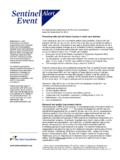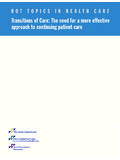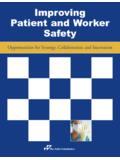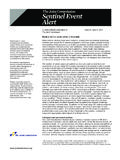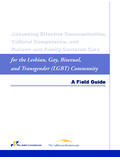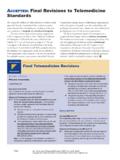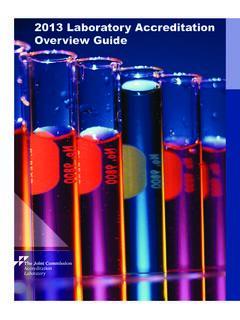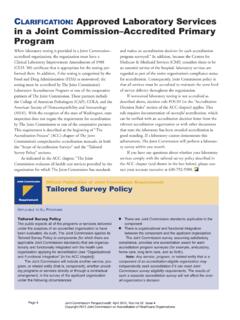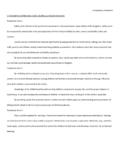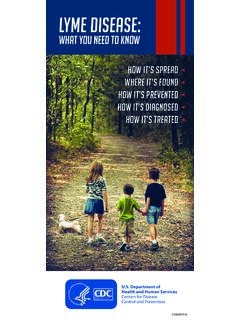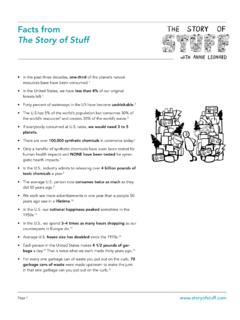Transcription of Environment of Care Management Plans - Joint Commission
1 The Joint Commission has identified the need to increase thefield s awareness and understanding of the Life Safety Code .*To address this need, The Joint Commission Perspectives publishes the column Clarifications and Expectations,authoredby George Mills, MBA, FASHE, CEM, CHFM, CHSP, director,Department of Engineering, The Joint Commission . This columnclarifies standards expectations and provides strategies for chal-lenging compliance issues, primarily in life safety and the envi-ronment of care, but also in the vital area of emergency manage-ment. You may wish to share the ideas and strategies in this col-umn with your facility s Management Plans are essential for taking charge ofthe Environment of care (EC).
2 These high-level documents,required of accredited organizations for all health care set-tings (with the exception of office-based surgery and homecare programs), should guide your organization s operationsto minimize risk and support strong performance in the sixkey EC functional areas shown in the box at Intent of the PlansAlthough Management Plans should bring the various ECfunctions into focus, they are not meant to be overly could think of them as a series of executive summarieswhich show that your organization is managing the EC andcomplying with Joint Commission standards. In fact, manage-ment Plans shouldn t necessarily detail howthings are donebut should provide assurance that there are pro cesses in placeto get things done and respond to risk.
3 For example, an organization s utilities Management plan might say:Although Acme Hospital does not monitor for Legionellabacteria, there is a process in place whereby the organiza-tion can implement mitigation strategies when notified bythe infection control department of a potential statement provides assurance that the organization has amitigation strategy and knows when to activate it. But it doesnot detail what the strategy is or how it will be this point, the utilities Management plan might refer to aseparate policy or procedure with greater detail about specificmitigation strategies and their uses.
4 Taking a Thoughtful ApproachAs your organization creates or revises its Management Plans ,keep the following points in mind: Don t cite the The Joint Commissionstandards related to EC is a helpful first step in developingmanagement Plans . Each Management plan must addressthe pertinent EC standards and their elements of perfor -mance (EPs), so it is crucial that plan developers under-stand what those EPs require. However, merely restatingthe EPs or listing standard numbers in the managementplans is not appropriate. Surveyors know the standards andEPs, so you don t need to repeat them in your manage-ment Plans .
5 Plus, the standards may change slightly fromEnvironment of Care Management PlansMaking Sure Your Plans Get the Job Done* Life Safety Code is a registered trademark of the National FireProtection Association, Quincy, Joint Commission s Environment of Care (EC) standards require organizations to develop manage mentplans in six functional areas*:1. Safety2. Security3. Hazardous materials and waste4. Fire safety5. Medical equipment6. Utilities * An organization is also required to have a written EmergencyOperations Plan and a current Statement of Conditions, but thesehave different parameters than Management Plans .
6 See the Emergency Management and Life Safety chapters in yourComprehensive Accreditation Manual for a complete Management Plans PlusPage 6 Joint Commission Perspectives , June 2013, Volume 33, Issue 6 Copyright 2013 The Joint Commissionyear to year, and it can be tedious to constantly amend aplan due to shifting standard-related content. With thatsaid, the safety officer may choose to annotate a mastercopy of the Management Plans with the standard numbersto ensure that the Plans address every relevant EP. This canalso help during survey because if needed, the surveyor canquickly see how your organization complies with specificstandards.
7 Determine the shape of the The JointCommission requires organizations to have managementplans that address the six EC functional areas, it is not pre-scriptive about the format of the Plans . For example, planscan be individual documents or consolidated into one doc-ument. Individual documents that address each aspect ofthe EC undoubtedly enhance the specificity of the man-agement Plans , making them unique for each aspect of theEC. However, this may prove too cumbersome for yourorganization and may cause unintended confusion. To streamline the Plans , you might want to write one setof consolidated Plans that covers all your organization sfunctions.
8 Another approach would be one document that coversthe topic areas that apply to all Management Plans andadjunct Plans that highlight the work specific to the vari-ous functional areas. The standards require that all man-agement Plans address the topics shown in the box at overall plan could describe each function as itrelates to the entire EC Management process, and detailedattachments can then dig more deeply into the particularsof each topic area for the six required Plans . Keep a consistent ensure that your manage-ment Plans are easy to navigate, understand, and use, youmay want to keep the structure of the Plans consistent.
9 Forexample, each plan could start with a mission and visionstatement, a description of plan scope, and a list of objec-tives. A plan could then list compliance details and endwith a brief discussion about how performance will bemeasured and how the plan will be evaluated. By keepingplans consistent, any individual can pick up any plan andknow where to find certain information. Cite supporting provide information and alsoprevent Management Plans from becoming unwieldy, youmight want to cite supporting policies in the Plans anddescribe how readers can access those policies. This mightinclude cross-referencing the appropriate policies and procedures or providing a list of them in an addendum tothe plan.
10 Comply with the strictest authority having jurisdiction (AHJ).Don t forget the rule of thumb that you must always com-ply with the strictest AHJ. For example, EC requirementsstate that only one fire drill per shift per year is needed infreestanding business occupancies. But if the local firemarshal requires more frequent drills, an organizationmust honor that requirement. Conversely, if the local AHJrequires only one drill every two years, an organization isstill required to have one per shift per year according toThe Joint Commission , which then acts as the strictestAHJ. Your Management Plans should highlight when theAHJ is not The Joint Commission and indicate that youare meeting the stricter authority s requirements.
